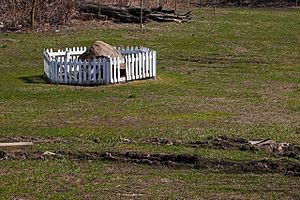Arbitration Rock facts for kids
The Arbitration Rock is a large rock that was placed in 1769. It marked the boundary between two old towns on Long Island: Newtown and Bushwick. Newtown was in Queens County (now the borough of Queens). Bushwick was in Kings County (now the borough of Brooklyn). So, this rock also showed the dividing line between these two counties in colonial New York. The rock is about the size of a Volkswagen Beetle car.
Contents
What is the Arbitration Rock?
The Arbitration Rock is a huge stone that helped settle a very old argument. It was used to mark the official border between two important areas. For many years, it was a key landmark for people living in Queens and Brooklyn.
A Long-Standing Border Dispute
A big argument about the border between Newtown and Bushwick started way back in 1661. People from one town would even throw stones at people from the other! This disagreement often showed the differences between the original Dutch settlers in Bushwick and the growing number of English colonists in Newtown.
In 1768, the government decided to create a group to draw a clear line. This group set the border in 1769. They measured the new border from this large rock. That's why it became known as the "Arbitration Rock." But the argument wasn't fully settled until 1880. That's when the state sent surveyors to check the exact spot on the old rock.
The Rock's Changing Importance
Throughout the 1800s, the Arbitration Rock was the official marker for land disputes. All property lines were measured from its center. This included the border of the New York City borough of Brooklyn.
In 1898, both Newtown and Bushwick became part of the bigger New York City. After this, the rock became less important. By 1917, it was almost completely covered by dirt and trash.
New York City changed the Brooklyn-Queens border again in 1925. This was to fix problems caused by the old straight line. Sometimes, the border ran right through the middle of houses! People had kitchens in Queens and living rooms in Brooklyn. This caused confusion about voting and taxes. A new, organized street plan was made for the two boroughs. The rock was no longer needed for its original purpose.
Lost and Found: The Rock's Rediscovery
The new borders placed the almost forgotten rock well inside Queens. Its purpose was gone, and the rock's important and quiet existence faded away. Street improvements in the 1930s buried the rock. It had been lying under Onderdonk Avenue for more than 10,000 years. This huge glacial boulder was hidden. Its location was forgotten, and the Arbitration Rock became like a forgotten story.
Interest in the rock as a historical item began to grow in the 1990s. After a seven-year search by experts, a huge crane dug deep into the ground. In December 2001, it lifted the massive rock out of the earth. It had been buried for about seventy years! The rock was then moved a few hundred feet. It now sits near the 18th-century Vander Ende–Onderdonk House.
A New Argument Over the Rock
Even after 340 years, the Arbitration Rock continued to be part of arguments. Once Queens found and moved the rock, Brooklyn officials quickly protested. They argued that the rock was part of their shared history. They felt they should have been included in the decision about where to put it.
The official historian for Queens replied that it belonged "In Queens, of course." He said, "While it was once on the border, the boulder has been in Queens for 77 years." This was since the boundaries were changed.
He even joked, "it should be cut in half and the other half should be a monument in Brooklyn." This was a wise solution, like the story of Solomon.


